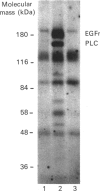Abstract
We have shown previously that exposure of a non-transformed continuous line of rat liver epithelial (WB) cells to epidermal growth factor (EGF), adrenaline, angiotensin II or [Arg8]vasopressin results in an accumulation of the inositol phosphates InsP1, InsP2 and InsP3 [Hepler, Earp & Harden (1988) J. Biol. Chem. 263, 7610-7619]. Studies were carried out with WB cells to determine whether the EGF receptor and other, non-tyrosine kinase, hormone receptors stimulate phosphoinositide hydrolysis by common, overlapping or separate pathways. The time courses for accumulation of inositol phosphates in response to angiotensin II and EGF were markedly different. Whereas angiotensin II stimulated a very rapid accumulation of inositol phosphates (maximal by 30 s), increases in the levels of inositol phosphates in response to EGF were measurable only following a 30 s lag period; maximal levels were attained by 7-8 min. Chelation of extracellular Ca2+ with EGTA did not modify this relative difference between angiotensin II and EGF in the time required to attain maximal phospholipase C activation. Under experimental conditions in which agonist-induced desensitization no longer occurred in these cells, the inositol phosphate responses to EGF and angiotensin II were additive, whereas those to angiotensin II and [Arg8]vasopressin were not additive. In crude WB lysates, angiotensin II, [Arg8]vasopressin and adrenaline each stimulated inositol phosphate formation in a guanine-nucleotide-dependent manner. In contrast, EGF failed to stimulate inositol phosphate formation in WB lysates in the presence or absence of guanosine 5'-[gamma-thio]triphosphate (GTP[S]), even though EGF retained the capacity to bind to and stimulate tyrosine phosphorylation of its own receptor. Pertussis toxin, at concentrations that fully ADP-ribosylate and functionally inactivate the inhibitory guanine-nucleotide regulatory protein of adenylate cyclase (Gi), had no effect on the capacity of EGF or hormones to stimulate inositol phosphate accumulation. In intact WB cells, the capacity of EGF, but not angiotensin II, to stimulate inositol phosphate accumulation was correlated with its capacity to stimulate tyrosine phosphorylation of the 148 kDa isoenzyme of phospholipase C. Taken together, these findings suggest that, whereas angiotensin II, [Arg8]vasopressin and alpha 1-adrenergic receptors are linked to activation of one or more phospholipase(s) C by an unidentified G-protein(s), the EGF receptor stimulates phosphoinositide hydrolysis by a different pathway, perhaps as a result of its capacity to stimulate tyrosine phosphorylation of phospholipase C-gamma.
Full text
PDF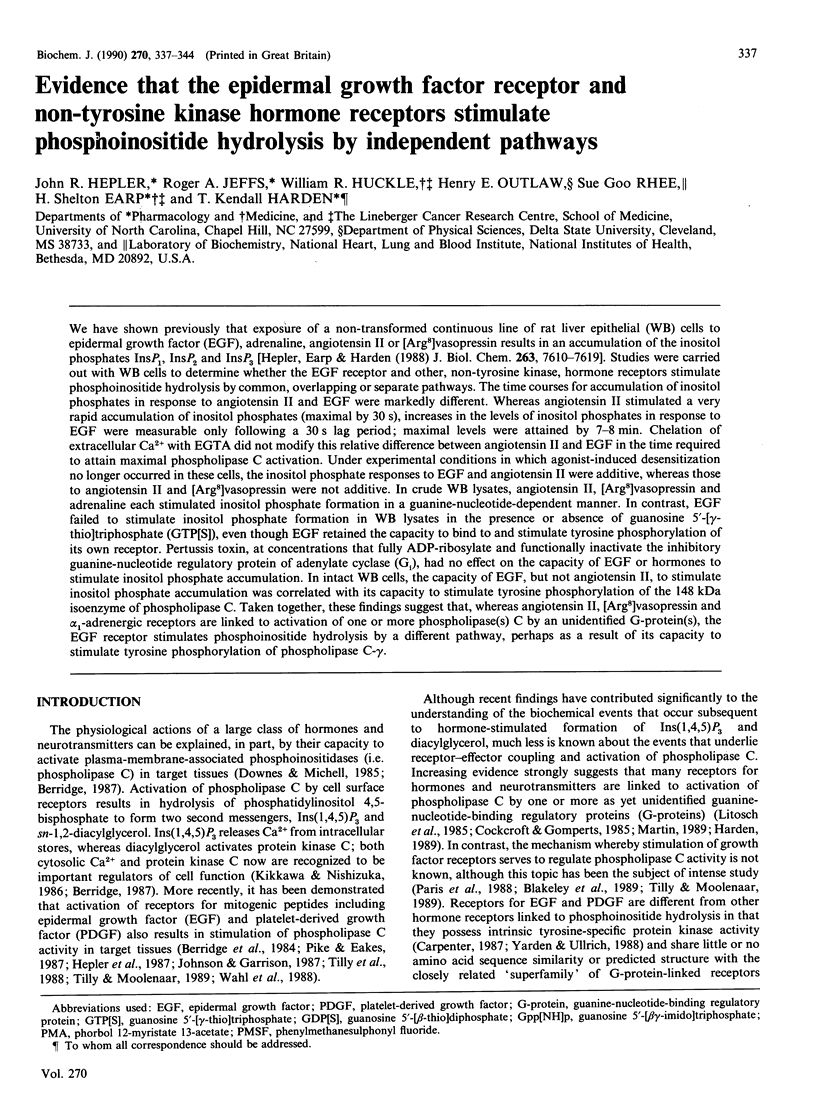
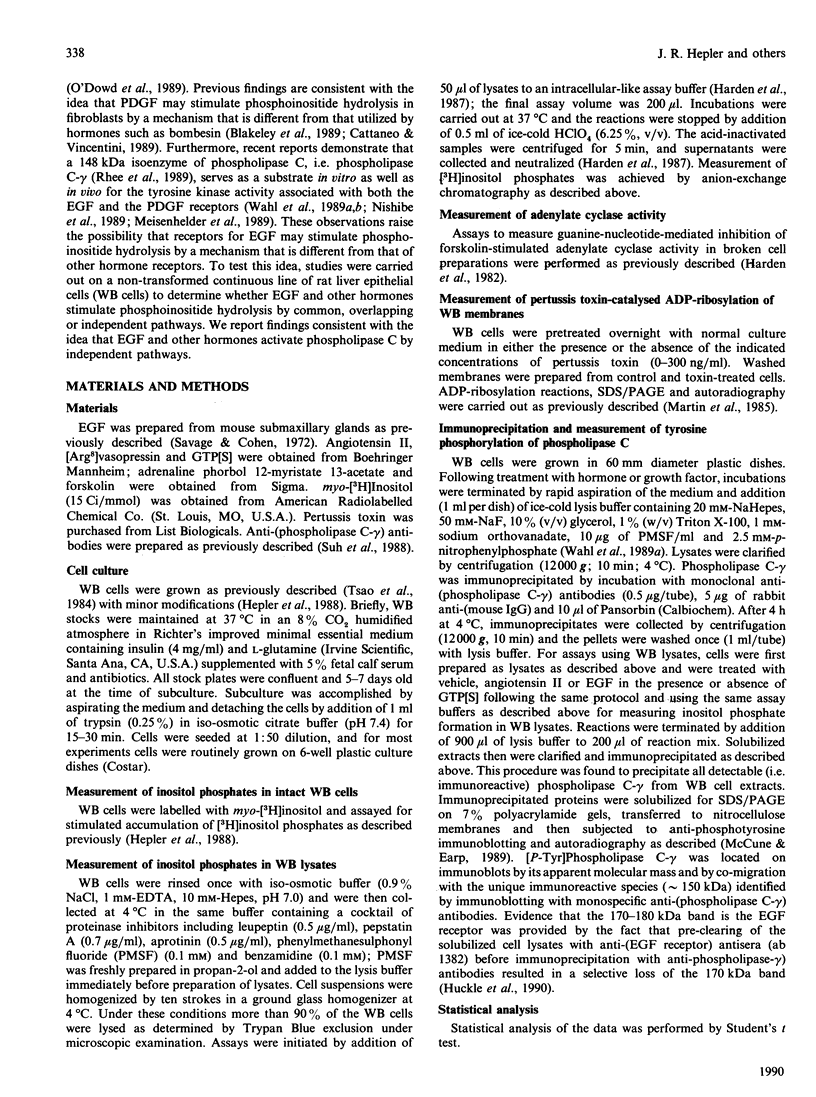
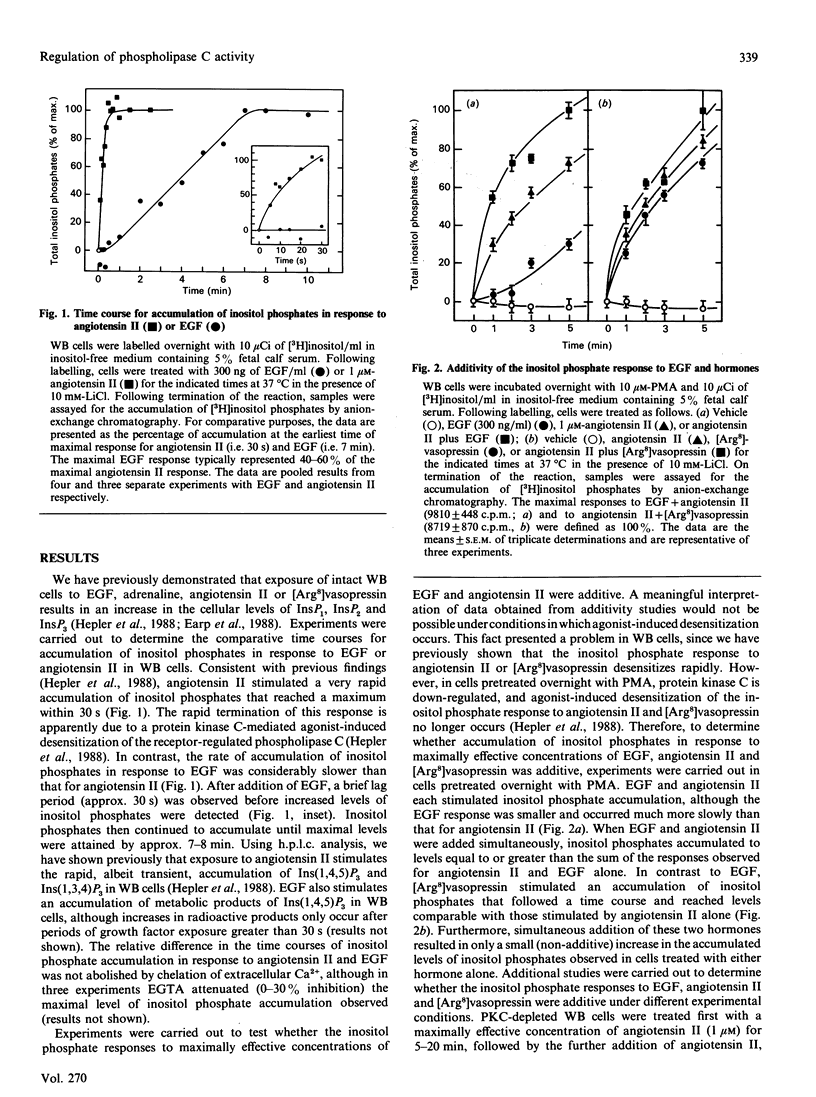
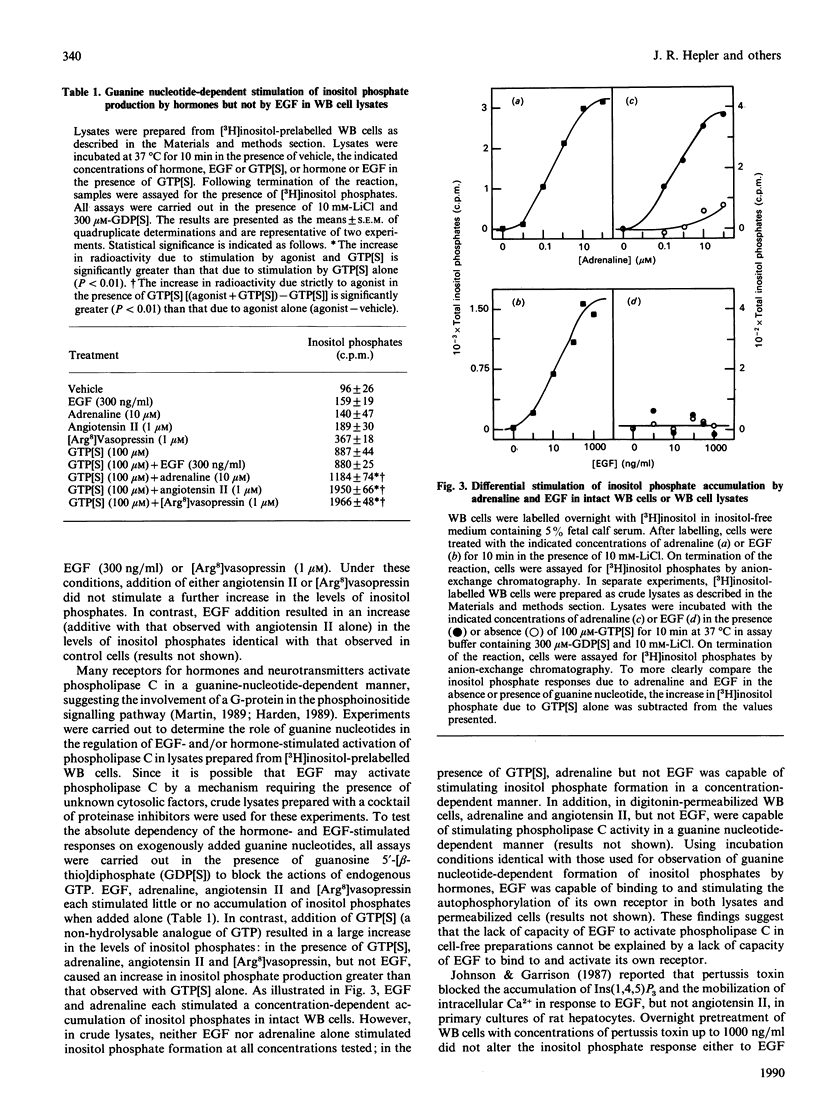
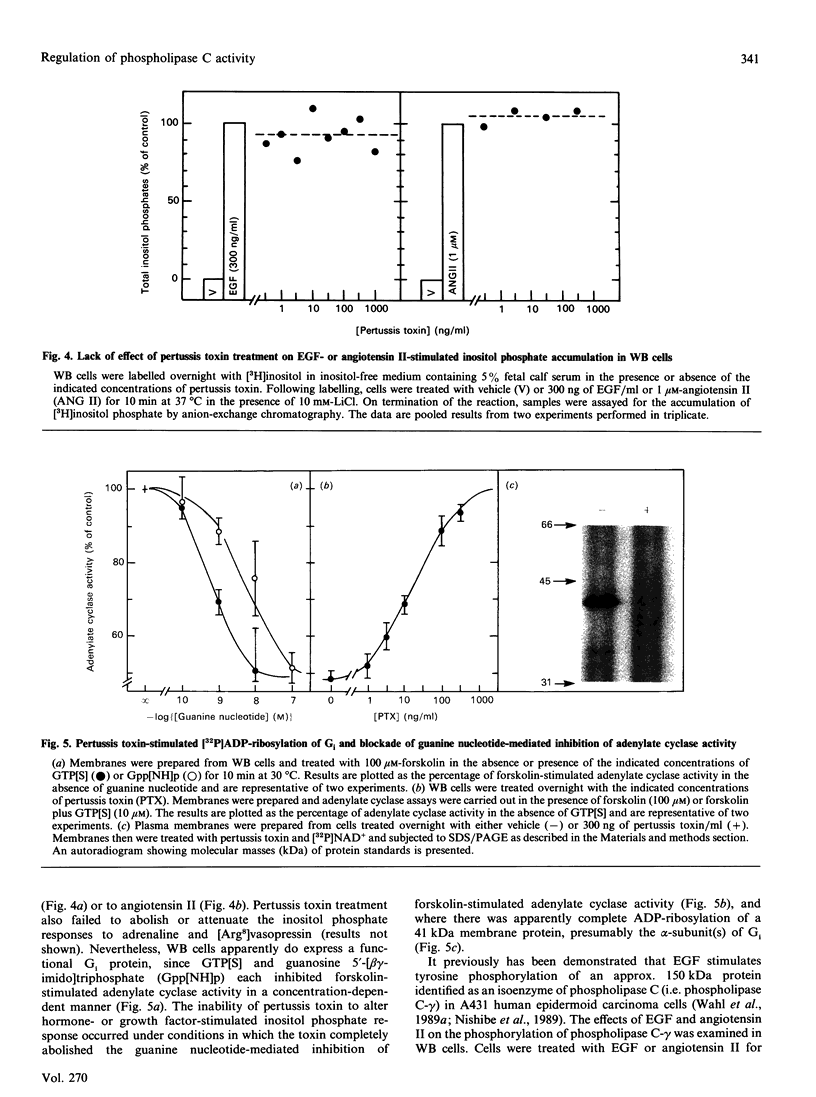
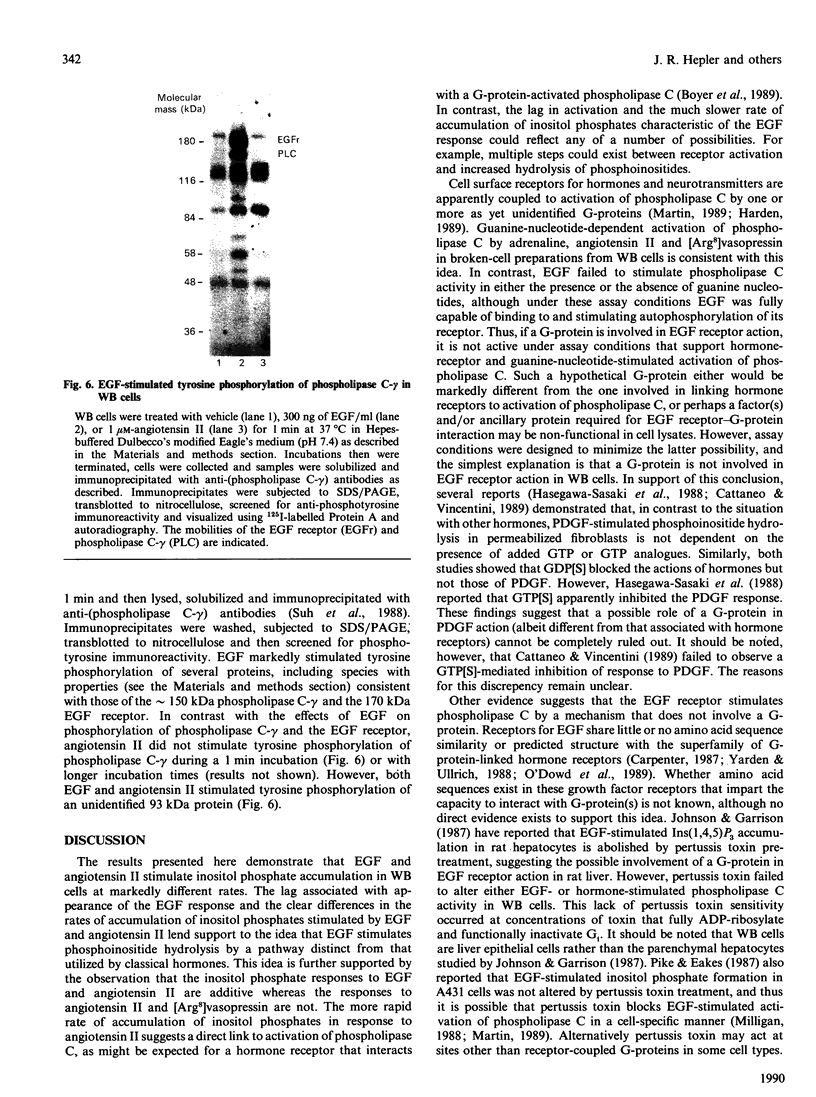
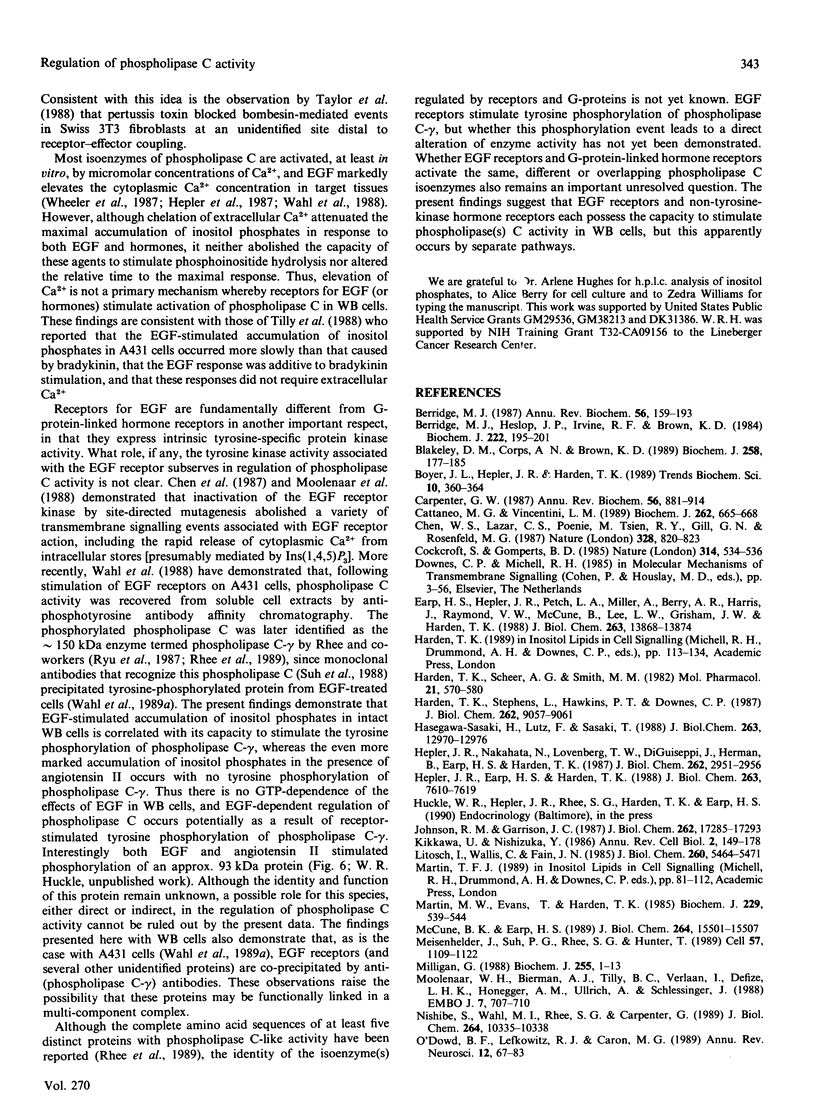
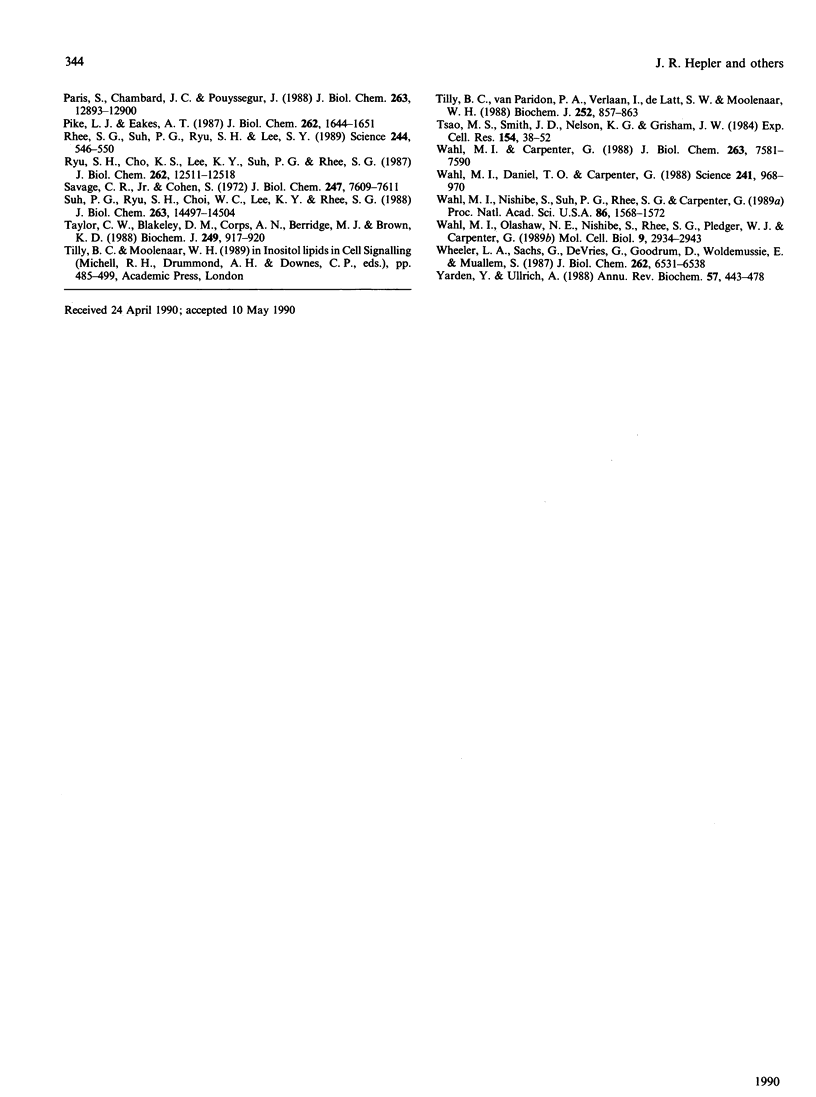
Images in this article
Selected References
These references are in PubMed. This may not be the complete list of references from this article.
- Berridge M. J., Heslop J. P., Irvine R. F., Brown K. D. Inositol trisphosphate formation and calcium mobilization in Swiss 3T3 cells in response to platelet-derived growth factor. Biochem J. 1984 Aug 15;222(1):195–201. doi: 10.1042/bj2220195. [DOI] [PMC free article] [PubMed] [Google Scholar]
- Berridge M. J. Inositol trisphosphate and diacylglycerol: two interacting second messengers. Annu Rev Biochem. 1987;56:159–193. doi: 10.1146/annurev.bi.56.070187.001111. [DOI] [PubMed] [Google Scholar]
- Blakeley D. M., Corps A. N., Brown K. D. Bombesin and platelet-derived growth factor stimulate formation of inositol phosphates and Ca2+ mobilization in Swiss 3T3 cells by different mechanisms. Biochem J. 1989 Feb 15;258(1):177–185. doi: 10.1042/bj2580177. [DOI] [PMC free article] [PubMed] [Google Scholar]
- Boyer J. L., Hepler J. R., Harden T. K. Hormone and growth factor receptor-mediated regulation of phospholipase C activity. Trends Pharmacol Sci. 1989 Sep;10(9):360–364. doi: 10.1016/0165-6147(89)90008-4. [DOI] [PubMed] [Google Scholar]
- Carpenter G. Receptors for epidermal growth factor and other polypeptide mitogens. Annu Rev Biochem. 1987;56:881–914. doi: 10.1146/annurev.bi.56.070187.004313. [DOI] [PubMed] [Google Scholar]
- Cattaneo M. G., Vicentini L. M. Differential mechanisms of inositol phosphate generation at the receptors for bombesin and platelet-derived growth factor. Biochem J. 1989 Sep 1;262(2):665–668. doi: 10.1042/bj2620665. [DOI] [PMC free article] [PubMed] [Google Scholar]
- Chen W. S., Lazar C. S., Poenie M., Tsien R. Y., Gill G. N., Rosenfeld M. G. Requirement for intrinsic protein tyrosine kinase in the immediate and late actions of the EGF receptor. 1987 Aug 27-Sep 2Nature. 328(6133):820–823. doi: 10.1038/328820a0. [DOI] [PubMed] [Google Scholar]
- Cockcroft S., Gomperts B. D. Role of guanine nucleotide binding protein in the activation of polyphosphoinositide phosphodiesterase. Nature. 1985 Apr 11;314(6011):534–536. doi: 10.1038/314534a0. [DOI] [PubMed] [Google Scholar]
- Earp H. S., Hepler J. R., Petch L. A., Miller A., Berry A. R., Harris J., Raymond V. W., McCune B. K., Lee L. W., Grisham J. W. Epidermal growth factor (EGF) and hormones stimulate phosphoinositide hydrolysis and increase EGF receptor protein synthesis and mRNA levels in rat liver epithelial cells. Evidence for protein kinase C-dependent and -independent pathways. J Biol Chem. 1988 Sep 25;263(27):13868–13874. [PubMed] [Google Scholar]
- Harden T. K., Scheer A. G., Smith M. M. Differential modification of the interaction of cardiac muscarinic cholinergic and beta-adrenergic receptors with a guanine nucleotide binding component(s). Mol Pharmacol. 1982 May;21(3):570–580. [PubMed] [Google Scholar]
- Harden T. K., Stephens L., Hawkins P. T., Downes C. P. Turkey erythrocyte membranes as a model for regulation of phospholipase C by guanine nucleotides. J Biol Chem. 1987 Jul 5;262(19):9057–9061. [PubMed] [Google Scholar]
- Hasegawa-Sasaki H., Lutz F., Sasaki T. Pathway of phospholipase C activation initiated with platelet-derived growth factor is different from that initiated with vasopressin and bombesin. J Biol Chem. 1988 Sep 15;263(26):12970–12976. [PubMed] [Google Scholar]
- Hepler J. R., Earp H. S., Harden T. K. Long-term phorbol ester treatment down-regulates protein kinase C and sensitizes the phosphoinositide signaling pathway to hormone and growth factor stimulation. Evidence for a role of protein kinase C in agonist-induced desensitization. J Biol Chem. 1988 Jun 5;263(16):7610–7619. [PubMed] [Google Scholar]
- Hepler J. R., Nakahata N., Lovenberg T. W., DiGuiseppi J., Herman B., Earp H. S., Harden T. K. Epidermal growth factor stimulates the rapid accumulation of inositol (1,4,5)-trisphosphate and a rise in cytosolic calcium mobilized from intracellular stores in A431 cells. J Biol Chem. 1987 Mar 5;262(7):2951–2956. [PubMed] [Google Scholar]
- Johnson R. M., Garrison J. C. Epidermal growth factor and angiotensin II stimulate formation of inositol 1,4,5- and inositol 1,3,4-trisphosphate in hepatocytes. Differential inhibition by pertussis toxin and phorbol 12-myristate 13-acetate. J Biol Chem. 1987 Dec 25;262(36):17285–17293. [PubMed] [Google Scholar]
- Kikkawa U., Nishizuka Y. The role of protein kinase C in transmembrane signalling. Annu Rev Cell Biol. 1986;2:149–178. doi: 10.1146/annurev.cb.02.110186.001053. [DOI] [PubMed] [Google Scholar]
- Litosch I., Wallis C., Fain J. N. 5-Hydroxytryptamine stimulates inositol phosphate production in a cell-free system from blowfly salivary glands. Evidence for a role of GTP in coupling receptor activation to phosphoinositide breakdown. J Biol Chem. 1985 May 10;260(9):5464–5471. [PubMed] [Google Scholar]
- Martin M. W., Evans T., Harden T. K. Further evidence that muscarinic cholinergic receptors of 1321N1 astrocytoma cells couple to a guanine nucleotide regulatory protein that is not Ni. Biochem J. 1985 Jul 15;229(2):539–544. doi: 10.1042/bj2290539. [DOI] [PMC free article] [PubMed] [Google Scholar]
- McCune B. K., Earp H. S. The epidermal growth factor receptor tyrosine kinase in liver epithelial cells. The effect of ligand-dependent changes in cellular location. J Biol Chem. 1989 Sep 15;264(26):15501–15507. [PubMed] [Google Scholar]
- Meisenhelder J., Suh P. G., Rhee S. G., Hunter T. Phospholipase C-gamma is a substrate for the PDGF and EGF receptor protein-tyrosine kinases in vivo and in vitro. Cell. 1989 Jun 30;57(7):1109–1122. doi: 10.1016/0092-8674(89)90048-2. [DOI] [PubMed] [Google Scholar]
- Milligan G. Techniques used in the identification and analysis of function of pertussis toxin-sensitive guanine nucleotide binding proteins. Biochem J. 1988 Oct 1;255(1):1–13. doi: 10.1042/bj2550001. [DOI] [PMC free article] [PubMed] [Google Scholar]
- Moolenaar W. H., Bierman A. J., Tilly B. C., Verlaan I., Defize L. H., Honegger A. M., Ullrich A., Schlessinger J. A point mutation at the ATP-binding site of the EGF-receptor abolishes signal transduction. EMBO J. 1988 Mar;7(3):707–710. doi: 10.1002/j.1460-2075.1988.tb02866.x. [DOI] [PMC free article] [PubMed] [Google Scholar]
- Nishibe S., Wahl M. I., Rhee S. G., Carpenter G. Tyrosine phosphorylation of phospholipase C-II in vitro by the epidermal growth factor receptor. J Biol Chem. 1989 Jun 25;264(18):10335–10338. [PubMed] [Google Scholar]
- O'Dowd B. F., Lefkowitz R. J., Caron M. G. Structure of the adrenergic and related receptors. Annu Rev Neurosci. 1989;12:67–83. doi: 10.1146/annurev.ne.12.030189.000435. [DOI] [PubMed] [Google Scholar]
- Paris S., Chambard J. C., Pouysségur J. Tyrosine kinase-activating growth factors potentiate thrombin- and AIF4- -induced phosphoinositide breakdown in hamster fibroblasts. Evidence for positive cross-talk between the two mitogenic signaling pathways. J Biol Chem. 1988 Sep 15;263(26):12893–12900. [PubMed] [Google Scholar]
- Pike L. J., Eakes A. T. Epidermal growth factor stimulates the production of phosphatidylinositol monophosphate and the breakdown of polyphosphoinositides in A431 cells. J Biol Chem. 1987 Feb 5;262(4):1644–1651. [PubMed] [Google Scholar]
- Rhee S. G., Suh P. G., Ryu S. H., Lee S. Y. Studies of inositol phospholipid-specific phospholipase C. Science. 1989 May 5;244(4904):546–550. doi: 10.1126/science.2541501. [DOI] [PubMed] [Google Scholar]
- Ryu S. H., Cho K. S., Lee K. Y., Suh P. G., Rhee S. G. Purification and characterization of two immunologically distinct phosphoinositide-specific phospholipases C from bovine brain. J Biol Chem. 1987 Sep 15;262(26):12511–12518. [PubMed] [Google Scholar]
- Savage C. R., Jr, Cohen S. Epidermal growth factor and a new derivative. Rapid isolation procedures and biological and chemical characterization. J Biol Chem. 1972 Dec 10;247(23):7609–7611. [PubMed] [Google Scholar]
- Suh P. G., Ryu S. H., Choi W. C., Lee K. Y., Rhee S. G. Monoclonal antibodies to three phospholipase C isozymes from bovine brain. J Biol Chem. 1988 Oct 5;263(28):14497–14504. [PubMed] [Google Scholar]
- Taylor C. W., Blakeley D. M., Corps A. N., Berridge M. J., Brown K. D. Effects of pertussis toxin on growth factor-stimulated inositol phosphate formation and DNA synthesis in Swiss 3T3 cells. Biochem J. 1988 Feb 1;249(3):917–920. doi: 10.1042/bj2490917. [DOI] [PMC free article] [PubMed] [Google Scholar]
- Tilly B. C., van Paridon P. A., Verlaan I., de Laat S. W., Moolenaar W. H. Epidermal-growth-factor-induced formation of inositol phosphates in human A431 cells. Differences from the effect of bradykinin. Biochem J. 1988 Jun 15;252(3):857–863. doi: 10.1042/bj2520857. [DOI] [PMC free article] [PubMed] [Google Scholar]
- Tsao M. S., Smith J. D., Nelson K. G., Grisham J. W. A diploid epithelial cell line from normal adult rat liver with phenotypic properties of 'oval' cells. Exp Cell Res. 1984 Sep;154(1):38–52. doi: 10.1016/0014-4827(84)90666-9. [DOI] [PubMed] [Google Scholar]
- Wahl M. I., Daniel T. O., Carpenter G. Antiphosphotyrosine recovery of phospholipase C activity after EGF treatment of A-431 cells. Science. 1988 Aug 19;241(4868):968–970. doi: 10.1126/science.2457254. [DOI] [PubMed] [Google Scholar]
- Wahl M. I., Nishibe S., Suh P. G., Rhee S. G., Carpenter G. Epidermal growth factor stimulates tyrosine phosphorylation of phospholipase C-II independently of receptor internalization and extracellular calcium. Proc Natl Acad Sci U S A. 1989 Mar;86(5):1568–1572. doi: 10.1073/pnas.86.5.1568. [DOI] [PMC free article] [PubMed] [Google Scholar]
- Wahl M. I., Olashaw N. E., Nishibe S., Rhee S. G., Pledger W. J., Carpenter G. Platelet-derived growth factor induces rapid and sustained tyrosine phosphorylation of phospholipase C-gamma in quiescent BALB/c 3T3 cells. Mol Cell Biol. 1989 Jul;9(7):2934–2943. doi: 10.1128/mcb.9.7.2934. [DOI] [PMC free article] [PubMed] [Google Scholar]
- Wahl M., Carpenter G. Regulation of epidermal growth factor-stimulated formation of inositol phosphates in A-431 cells by calcium and protein kinase C. J Biol Chem. 1988 Jun 5;263(16):7581–7590. [PubMed] [Google Scholar]
- Wheeler L. A., Sachs G., De Vries G., Goodrum D., Woldemussie E., Muallem S. Manoalide, a natural sesterterpenoid that inhibits calcium channels. J Biol Chem. 1987 May 15;262(14):6531–6538. [PubMed] [Google Scholar]
- Yarden Y., Ullrich A. Growth factor receptor tyrosine kinases. Annu Rev Biochem. 1988;57:443–478. doi: 10.1146/annurev.bi.57.070188.002303. [DOI] [PubMed] [Google Scholar]




